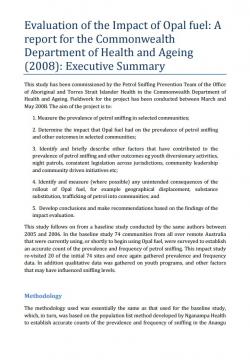Evaluation of the Impact of Opal fuel: Executive summary

This report is an executive summary of the evaluation of the impact of Opal fuel on the prevalence of petrol sniffing in selected communities. This contains data collected between March and May 2008.
This study has been commissioned by the Petrol Sniffing Prevention Team of the Office of Aboriginal and Torres Strait Islander Health in the Commonwealth Department of Health and Ageing. Fieldwork for the project has been conducted between March and May 2008. The aim of the project is to:
1. Measure the prevalence of petrol sniffing in selected communities;
2. Determine the impact that Opal fuel had on the prevalence of petrol sniffing and other outcomes in selected communities;
3. Identify and briefly describe other factors that have contributed to the prevalence of petrol sniffing and other outcomes eg youth diversionary activities, night patrols, consistent legislation across jurisdictions, community leadership and community driven initiatives etc;
4. Identify and measure (where possible) any unintended consequences of the rollout of Opal fuel, for example geographical displacement, substance substitution, trafficking of petrol into communities; and
5. Develop conclusions and make recommendations based on the findings of the impact evaluation.
This study follows on from a baseline study conducted by the same authors between 2005 and 2006. In the baseline study 74 communities from all over remote Australia that were currently using, or shortly to begin using Opal fuel, were surveyed to establish an accurate count of the prevalence and frequency of petrol sniffing. This impact study re-visited 20 of the initial 74 sites and once again gathered prevalence and frequency data. In addition qualitative data was gathered on youth programs, and other factors that may have influenced sniffing levels.
Methodology
The methodology used was essentially the same as that used for the baseline study, which, in turn, was based on the population list method developed by Nganampa Health to establish accurate counts of the prevalence and frequency of sniffing in the Anangu Pitjantjatjara lands in South Australia. Data collectors visited each of the 20 sites and gathered quantitative data on the prevalence and frequency of sniffing, and qualitative data on the perception of the impact of Opal fuel, and the funding, operation and quality of youth services in each site.
This study encountered methodological challenges associated with establishing prevalence and frequency in situations where sniffing is sporadic, and often at very low levels. To counter these difficulties a key informant methodology was used in sites where sniffing levels were less than 10 people. The labeling of categories of petrol sniffing was also modified from that used in the baseline study, in that those who were believed to have sniffed petrol within the preceding six months, but not to have engaged in regular use, were defined as ‘occasional’ sniffers rather than ‘experimental’ sniffers. The reason for the change is that, in a context where availability of sniffable petrol has been reduced or eliminated, sporadic petrol sniffing is as likely to be a product of reduced availability rather than youthful experimentation.
Results
This study allows us to make a number of clear statements about the change in levels of sniffing in the communities in the sample:
-
the prevalence of sniffing has declined in 17 out of the 20 communities in the study;
-
across the whole sample there has been a decrease of 431 (70%) in the number of people sniffing between baseline and follow up;
-
in nine communities in the sample there was no sniffing at the time of follow up data collection, compared with two communities at baseline;
-
in three communities in the sample the prevalence of sniffing has risen. In two of these cases there appear to be particular supply related factors at work, and RULP is easily available. In the third site there is substantial sniffing of aerosols, not petrol;
-
Central Australia and the APY Lands are the regions with the largest decreases in prevalence of sniffing, with 94% and 93% decreases respectively;
-
the number of people sniffing has dropped substantially across all frequency groups, with a fall of 60% in the number of people sniffing at occasional levels, of 85% at regular light levels, and of 90% at regular heavy levels;
-
the substantial drop in the number of people sniffing at regular heavy levels indicates a comparable substantial decrease in the negative social impact caused by sniffing in communities in the sample, this is supported by qualitative feedback;
-
we found no reports of individuals accessing substance use services to help with the move away from sniffing;
-
there is a statistically significant relationship between the distance from each community to the nearest ULP outlet, and the size of the decrease in the prevalence of sniffing at each community, which indicates that the use of Opal fuel has had a significant role in the decrease in the prevalence of sniffing; and
-
qualitative feedback indicates that most residents of the communities who have experienced a decline in sniffing attribute the cause of that decline, at least in part, to the introduction of Opal fuel.
These conclusions point to a positive change in the number of people sniffing, and the frequency with which they sniff in most communities in the sample. This change cannot be solely attributed to the use of Opal fuel, as two communities who have experienced no change in the availability of petrol also recorded decreases in prevalence between baseline and follow up. However, as noted, many residents of the sample communities believed that Opal fuel had played a significant role in the reduction of sniffing in their community.
Conclusions can also be drawn about the provision of youth services in communities within the sample:
-
14 communities in the sample had a youth program at the time of follow up data collection and 6 did not;
-
8 out of 20 communities experienced an increase in the availability of youth services between baseline and follow up;
-
7 out of 20 communities experienced no change in the availability of youth services between baseline and follow up (3 of which had none at either point in time);
-
2 out of 20 communities experienced a decrease in the availability of youth services between baseline and follow up;
-
there has been no coordination between the provision of Opal fuel and access to youth services in communities in the sample;
-
the quality and size of the youth programs varied substantially across the sample; and
-
youth services were more consistent and of better quality in regions where centralised support was available.
In summary the access to and quality of youth services were patchy, and the funding sources for youth services were widely varied. There was no correlation between the provision of youth services and the size of the decrease in the prevalence of sniffing. However, given the variation in the quality of the youth programs available, this is not unexpected.
In addition to these summary conclusions, we feel that it is appropriate to issue site alerts for three communities in the sample (identities of communities removed).
Recommendations
The recommendations cover three areas – the need for, proposed design and implementation of ongoing monitoring, the need for youth services and a proposal for the best system to improve the quality of existing youth services, and the need for research into the impact of Opal fuel on the engines of boats.
- Monitoring
The initial recommendation regarding monitoring is that it is essential that an ongoing bureaucratic presence on volatile inhalants is maintained. This presence can function to maintain monitoring, and respond to changes in sniffing levels in particular locations and on a national level if necessary. The authors urge ongoing monitoring of levels of sniffing of all volatiles. We propose a design of re-visiting the sites in this sample every 2 years, and the use of the methodology used in this study.
- Youth Services
Additional funding is needed in the six sites with no youth services in order to enable youth services to be successfully run. In addition both the Top End and Far North Queensland regions would benefit from the establishment of a centralised agency that provides support to youth workers in the communities of the region.
- The impact of Opal fuel on the engines of boats
An investigation needs to be made into the impact of Opal fuel on the engines of boats.
- Reminders to Councils to stipulate that contractors use Opal fuel
Feedback indicates that contractor’s equipment is a common source of ULP used for sniffing. We recommend that educative material and verbal reminders given by staff working with communities experiencing sniffing stress the need for Councils and other employers to stipulate that contractors must use Opal fuel, and lock away any volatile substances such as glues that they use.
This is a summary of a report written by Peter d’Abbs (James Cook University) and Gillian Shaw (Bowchung Pty Ltd) for the Commonwealth Department of Health and Ageing in 2008.






